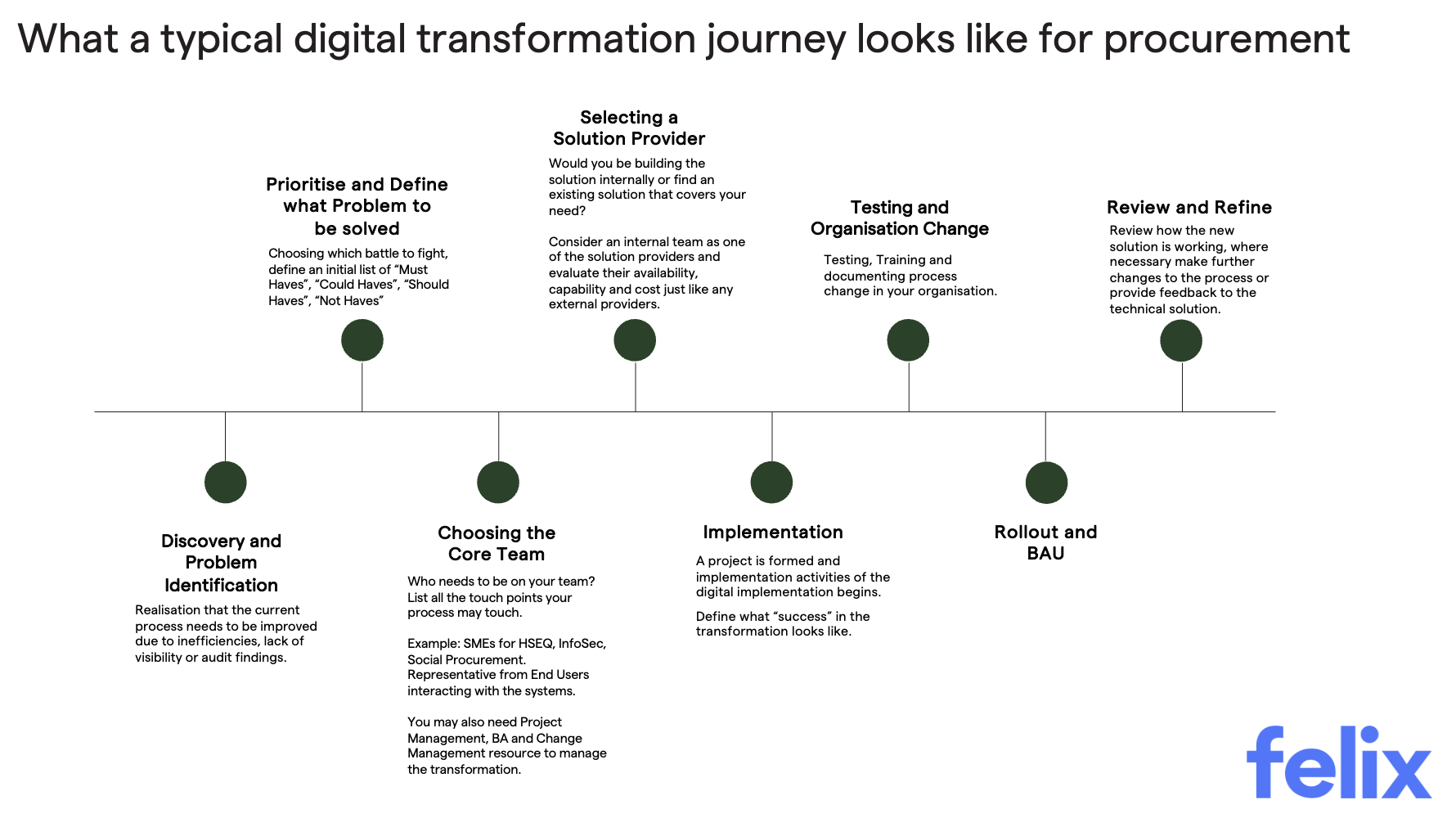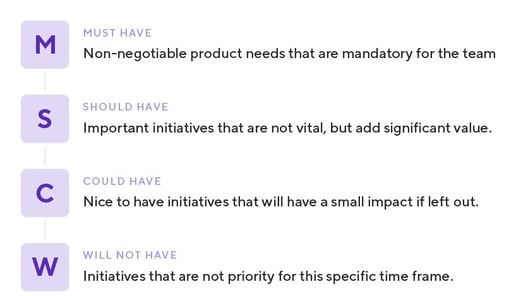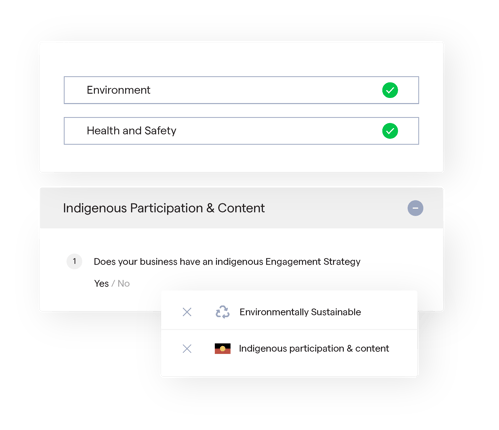The following is taken from our webinar “Tips for successful procurement tech implementation”. In part 1, we start by examining a typical journey that organisations go through, broken into different stages.
If you’d like to watch the full webinar, please click here.

We always start with a discovery and the problem identification phase. This is where a procurement department or a compliance department looks at the problem that they are currently having, look at the process they're currently doing, where the areas can be improved due to inefficiency, etc.
An example: It may be the fact that you are doing supplier onboarding on paper form. You find it extremely hard to get a holistic view of who’s registered and who's not registered, and data being stored in various places, including PDF forms in SharePoint, which is difficult to retrieve.
Once you identify a number of problems that your department and your role require from the procurement and risk management perspective, you would then prioritise the problem and how they should be solved.
There are a lot of problems in an organisation and it would be nice to solve all of them in one go with a digital solution. But this is actually not realistic, there will be some tradeoffs and this particular exercise in the second stage is to find out what the most valuable one that you must solve is - therefore we must have; some could be optional; could have or should have.

Source: ProductPlan
So you have a prioritised list of the various problems that you identified from the first exercise then you can then go and choose your team of experts who will be helping you to implement this particular transformation.
Another thing is your processes may touch various other people.
In the example mentioned, there will be your health and safety quality and environmental expertise - because you're getting them on board, you're getting them compliance to your organisation’s risk management requirements.
Information security is another area that you would likely have a touchpoint as a vendor gets onto a procurement platform, particularly in the most recent period of time, InfoSec has become a primary focus for any enterprise organisation. You want to make sure that whoever you bring aboard provides that level of security.
Other areas, such as social procurement or modern slavery are items that you may have current requirements to report on. With these representatives of people who are your SMEs, they will help you drive that transformation, define what is needed and most importantly, you also would want to engage with the end users, particularly your commercial managers, your contract managers.
They are, after all, the users who will be using whatever solution that comes up at the end of your project and they will be operating that particular solution on a day-to-day basis. That buy-in is actually extremely essential.

Having the core team of business expertise, you may need additional help depending on the size of your organisation. You may also need the resources from project management, business analysis or change management to manage the journey of moving from the current state to the future state.
Now with all these things being clear, you would then look into selecting the right provider.
One of the paths is you could build the solution yourself, but with the problem identified and prioritised; with the team chosen, you would then evaluate:
“Would it be a better solution to find an existing provider who already has an application available for use that is relatively closely matched with your requirements versus something you build your own?”
There're pros and cons, of course. A ready-made cloud-based solution means that your deployment time is significantly shortened because the platform is already built - it's ready to use. It may not fit all the processes that you currently have. There will be some tradeoffs, or that you may need to make some small process adjustments along the way if you find an existing provider.
It's actually not a bad deal in terms of looking for an external solution like that because as long as you cover 80% of your needs, the other bits are really value added. Along the way, the time saving benefit is incredible if you find a good partner who can provide what you need from an existing product.
--
Mini Q&A
Q: Just before you move on to the implementation stage, would you have any advice - or what you've seen done well in that evaluation process when selecting a solution provider?
Do you think that buyers looking for software should be really delving into an organisation and ask questions like “what is your implementation process?”, “how do you support us as an organisation?”; or do you think that can be learned? Have you got any advice for the listeners out there?
A: This is a very good question. The provider you are selecting is effectively your partner. One of the key things is how the collaboration model with this solution provider - being an external party or your even your internal team if you chose that pathway - would work during that implementation.
You would see on in the market there will be some implementation and some providers who just provide the implementation service with no consulting elements within the offering.
Depending on the maturity, that may or may not work for your organisation. In most cases, we probably think that it is best to find a solution provider that will actually have some knowledge of best practice and be able to share those success stories and best practices with you as part of that implementation.
It's really not much of a point if you find an implementation partner who would just do whatever you say because the key point is you don't want to replicate something that is not efficient digitally.
Someone with a bit of consulting elements within that process can give you that feedback, which will allow you to identify areas of your existing process that may not be optimal, and you will be able to leverage this digital transformation to actually improve efficiency further.

Then we go into the implementation phase, which is where a lot of the key activities will happen: configuring the solution or developing a solution; getting the actual digital solution ready; having new processes and workflow already.
An important point to remember, at the beginning of the implementation phase, be very clear of what you define as success for your organisation.
Now we have gone from stage #2, where you have a prioritised list and now getting into this implementation stage, things may come into different time frames because, again, that's the nature of the project. You will be unlikely to solve all problems in one go.
At a different stage, what do your key success criteria look like? Would it be the number of vendors who are in your database that allow you to generate certain reports?
You may have a key metric in terms of business intelligence, e.g. the ability to find out the number of Indigenous suppliers in your supply chain for a particular product and service category, which you can define because previously you may take 2-3 days to look for all the documentation. Now, with a digital system, you will be able to define new metrics and be able to produce some of these reports much quicker.

These are just examples, but ultimately, you should look at how the system would be able to solve and bring value to your organisation - either by reducing the time span, therefore reducing the overhead, or bringing you certain information that you wouldn't have previously.
----
Moving on, obviously you would be starting the testing of the solution, making sure that it works and starting that deployment across your organisation.
Do not underestimate the organisational change element. This is an extremely important process to ensure it is successful across your organisation.
We will cover more on change management later, but this is a key point to do right, and if you do this right, I'm sure you will get tremendous value from the transformation.
Then obviously the rollout and your business as usual. All of our modern-day system processes and solutions, we employ the practice of review and refine, and that's the same of your typical management system, your ISO type management system, as well as basically generally a good practice.
Whatever solution that you have made is not a static situation and it needs to evolve. Thus, it's good to have a regular periodic review.
It also helps as you gain experience in running the digital solution, you may find additional ways to further improve that process as well, and therefore continues with finding how you want the solution to work.
 Source: Avid Open Access
Source: Avid Open Access
---
Mini Q&A
Q: I wanted to ask, does this typical digital transformation journey apply to all types of projects in the same breath, are there any industry specific differences or is it all relatively the same process? And if executed well, your project should be a success?
A: This is rather generic. If you run this type of framework for a different industry, it should work.
Obviously, the specific outcome will be different based on your different organisation and different needs, but if you follow the framework from start to the end and manage this well, you're almost certain that your implementation would be managed in such a manner that it’s value orientated, and you bring value into your own organisation.
-----
Stay tuned for the next part where we’ll discuss different approaches to implementation, such as agile and waterfall.
----
Watch the full webinar Tips for Successful Procurement Tech Implementation.

Related Articles

Comparing different approaches to procurement tech implementation (Part 2)
Previously, we’ve discussed the typical stages of a digital transformation. In this next post, let’s talk through some of the different implementation approaches and their pros and cons, e.g. waterfall, agile, etc.

Software implementation bottlenecks and how to overcome them (Part 3)
Previously, we've stepped through a typical technology implementation process and then the methodologies that you can apply: Agile versus waterfall, build versus buy.
In this post, let’s dive into where bottlenecks normally occur in the delivery of an implementation or a project or what steps the project tends to get stuck at.

Cyber security compliance: the key to building trust with our customers
In today's digital landscape, where cyber threats loom large and data breaches dominate headlines (think Optus and Medibank), effective cyber security compliance is no longer optional – it's essential.
Let's stay in touch
Get the monthly dose of supply chain, procurement and technology insights with the Felix newsletter.




